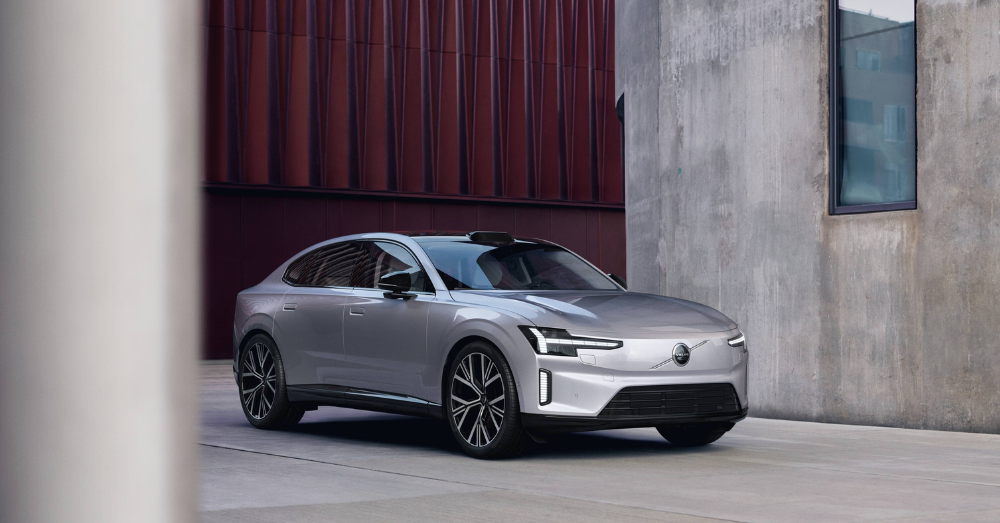Automakers have been working tirelessly to cut their carbon footprint, and the new Volvo ES90 is ready to show how it’s leading the way.
Discover how Volvo’s electric ES90 sedan cuts emissions by 50% compared to hybrid models through innovative use of recycled materials, climate-neutral manufacturing, and 800-volt charging technology. With a carbon footprint of just 26 tons using wind energy and featuring 29% recycled aluminum plus blockchain-tracked battery components, this luxury EV proves sustainable design doesn’t mean compromising on performance. Production begins late 2025 with deliveries starting in the spring of 2026.
The Most Climate-Friendly Model
The new, fully electric ES 90 is the most climate-friendly car to come out of the Volvo brand so far. It has the lowest carbon footprint of any Volvo car, thanks to the sustainability efforts that allow it to use recycled materials and climate-neutral production. Depending on the type of energy used, this car has a very small carbon footprint, which should be something other automakers pay close attention to, especially if they are working toward reducing their impact on the environment as a whole. The ES90 is the electric vehicle that makes a lot of sense, especially for drivers looking for the most eco-friendly car on the market.
Going Above Existing Legislation
Most companies work to keep things the way they are and are more than willing to pay for energy credits or to avoid change, but not Volvo. You might think that stricter regulations would mean working to meet them and not going above them, but that’s not what Volvo is about. Their goal is to achieve net-zero greenhouse gas emissions by 2040 while being a leader in electrification. The ES90 is a pathway to make that happen.
“We go above and beyond existing legislation and have clear ambitions because that is important to us.”
– Vanessa Butani, Head of Global Sustainability at Volvo Cars
What is a Life Cycle Assessment (LCA)?
Volvo is the first automaker to release LCA reports for its vehicles. This has been part of the equation for Volvo since its first electric car hit the market in 2019. By making this report public, the goal is to help customers be more aware of how their vehicles impact the environment and make informed decisions. This report tells a customer how a vehicle impacts the environment. So far, Volvo has issued LCA reports for five different models: EX40, EC40, EX30, EX90, and the new ES90.
Stainable Designs of the ES90
The new Volvo ES90 is a fully electric car with zero tailpipe emissions and its been fully designed with sustainability in mind. This means building the electric powertrain that allows the car to drive without expelling harmful emission, but also using materials that are recycled, reused, or produced using a net-zero carbon footprint.
The Electrical System
The 800-volt electrical system used in the ES90 is made with lighter components that previous systems. This reduces the car’s weight and increases its charging energy efficiency. This is only one example of how Volvo has worked to improve its manufacturing process and reduce its carbon footprint. The car’s design is made to be the most aerodynamic in the history of Volvo, with a drag coefficient of 0.25.
In addition to the electrical system and the design, the ES90 is also made with 29% recycled aluminum, 18% recycled steel, and 16% recycled polymers. It also has bio-based materials, including SC-certified wood in the cabin area.
Tracking All the Materials
In order for Volvo to fully commit to a car being sustainable, they need to know where the materials are coming from that are supplied through the supply chain. In order to do this, they created the world-first battery passport, which is based on blockchain technology. This allows the company to track the origin of raw materials and understand the overall health of the battery. To make this happen, Volvo must work with suppliers that are just as committed to sustainability as they are.
A Different Type of Gas
The Volvo ES90 is an all-electric car, why would we need to talk about gas at all? The manufacturing process uses some gas and the plant where the car is made switched from natural gas to biogas, which has led to a 50% carbon reduction per vehicle during the manufacturing process.
Supply Chain Involvement
The supply chain is an important part of being sustainable. Volvo is working directly with suppliers to ensure improved sustainability. Some suppliers requested to set targets toward climate-neutral energy sources in their operations, which contributes to Volvo’s overall neutral impact on the climate.
Volvo has required suppliers to declare recycled material content since 2023, which helps to improve the sustainability focus of the company.
Standardizing Carbon Neutrality
Volvo is setting new standards in carbon neutrality and sustainability. So far, 11 direct contracted suppliers use 100% renewable electricity in their manufacturing steps, which reduces the carbon footprint of Volvo cars by 0.1 tons of CO2 per vehicle.
The new Volvo ES90 is only the beginning of Volvo’s commitment to improving its impact on the environment, which should set new standards for other automakers to follow. Will these sustainability efforts also spread to other industries and help build a world in which the environment is more important than manufacturing?
